
Dr. Ramez
Lec. 1
METABOLIC RESPONSE IN
INJURY
Tues. 17 / 2 / 2015
DONE BY : Ali Kareem
مكتب اشور لالستنساخ
2014 – 2015

Metabolic Response in Injury Dr. Ramez
17-2-2015
2
Metabolic response in injury
2 distinct periods of the post-traumatic responses
- Ebb phase
- Flow phase
Ebb or shock phase
Immediately following injury
Usually brief in duration; 12 to 24 hours
Reduce: Blood pressure, cardiac output, body temperature and oxygen
consumption
Often associated with hemorrhage, resulted in hypoperfusion and lactic
acidosis
With restoration of blood volume
more accelerated responses
Flow phase
Hypermetabolism
- Increase in basal metabolic rate
- Increased oxygen consumption
- Degree related to severity of inflammatory response
- Temperature: reasonable indicator
Increased cardiac output, increased urinary nitrogen losses, altered glucose
metabolism, accelerated tissue catabolism
Accidental injury similar to elective operation, but much more intensive and
extend over a long period
Altered glucose metabolism
Hyperglycemia
- Ebb phase
Parallel severity of stress

Metabolic Response in Injury Dr. Ramez
17-2-2015
3
Low insulin levels
Glucose production only slightly elevated
- Flow phase: hyperglycemia persist
Insulin levels-normal or elevated
Increase hepatic glucose production
Profound insulin resistance
Alteration in protein metabolism
Extensive urinary nitrogen loss
- Related to extent of trauma
- But also depend on previous nutritional status, age, sex (muscle mass)
Unfed patients
- Protein breakdown > synthesis: negative balance
Exogenous calories and nitrogen
increase protein synthesis, nitrogen loss
not attenuated
Alteration in fat metabolism
Stored triglyceride: mobilized
Oxidized at accelerated rate (lipolysis)
Ketosis is blunted
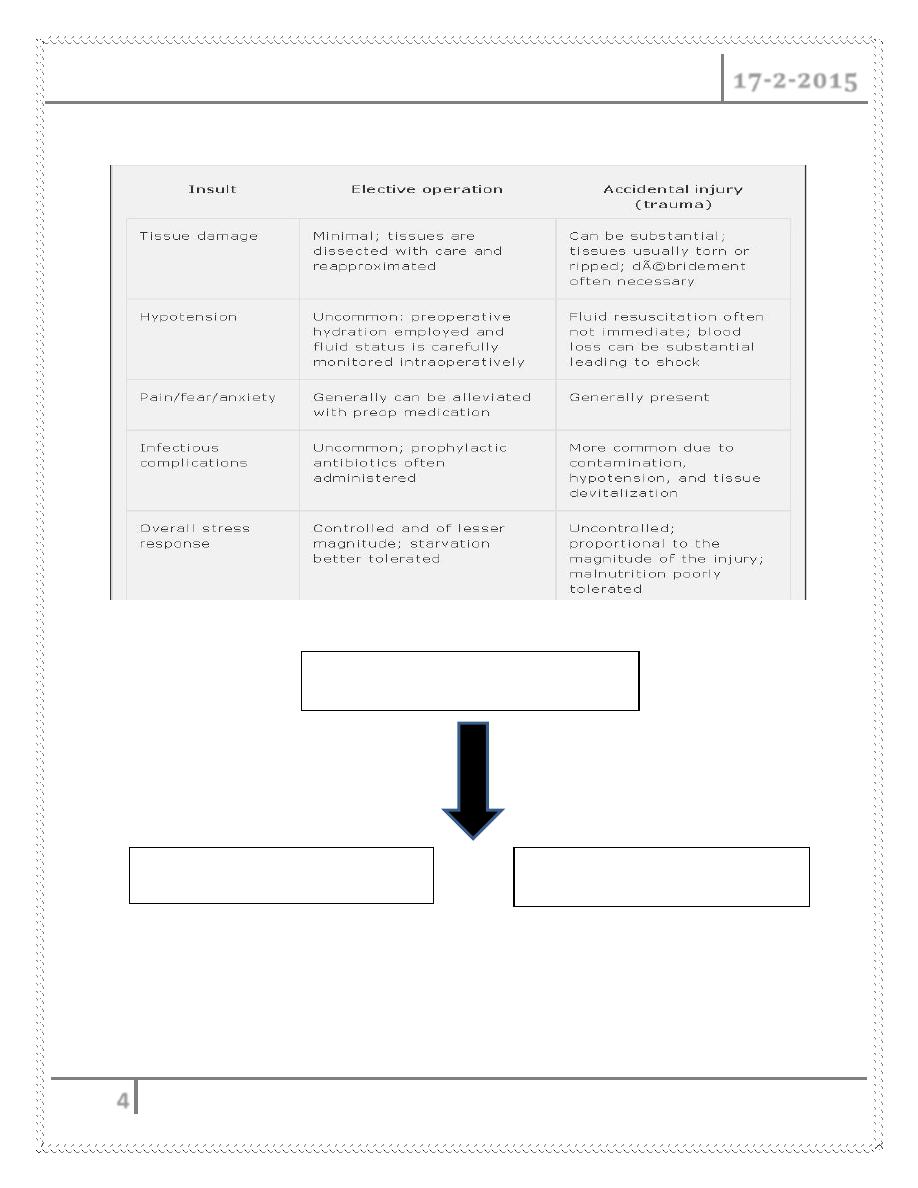
Metabolic Response in Injury Dr. Ramez
17-2-2015
4
Difference between elective and accidental injury
Injury response
Neurohormonal
Inflammatory
+
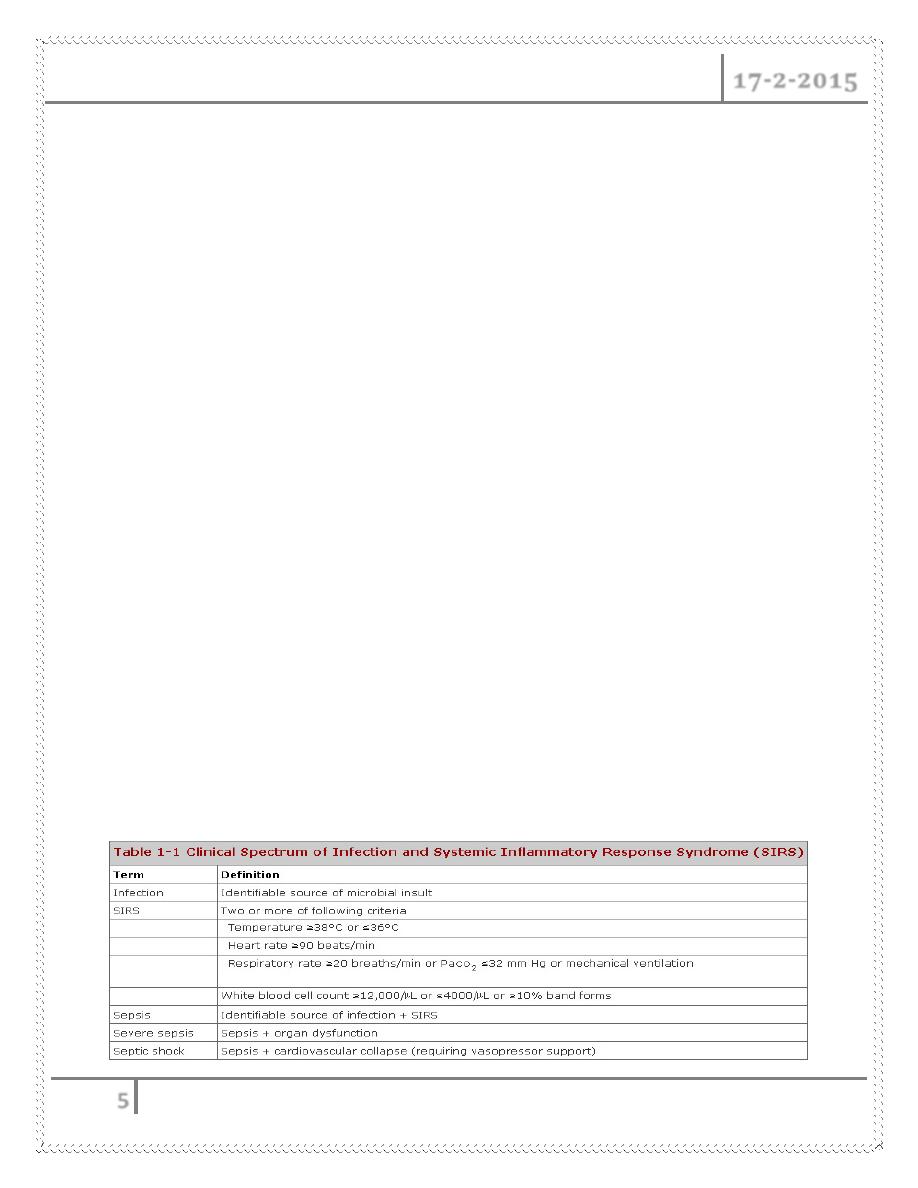
Metabolic Response in Injury Dr. Ramez
17-2-2015
5
Inflammation
Inflammatory response
- Primitive
- Complex
- Nonspecific immune system
Inflammatory
change in body composition
acute challenge to
homeostasis
Inflammation :
Localized
- Rubor(redness)
- Tumor(swelling)
- Calor(pain)
- Dolor(heat)
- Function laesa (loss of function)
Systemic
- Hypermetabolism
- Body protein catabolism
- Insulin resistance
- Fever
- Acute phase protein response
Dysregulation
Septic multiple organ failure (major cause of death in ICU)
10
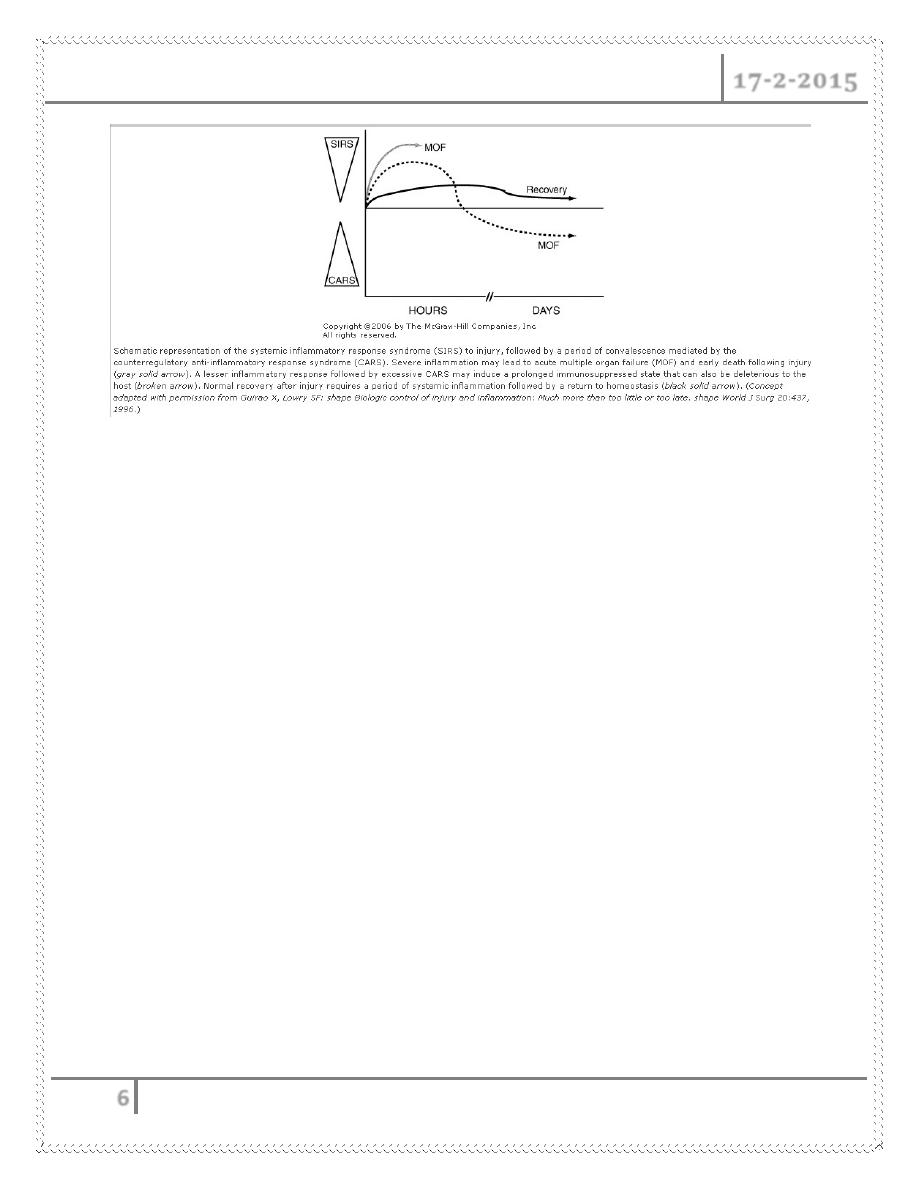
Metabolic Response in Injury Dr. Ramez
17-2-2015
6
Advantages of inflammatory response
Mobilization of fuel and substrates from muscle and adipose tissue to
maximize visceral functions (gluconeogenesis, glutamine synthesis, acute
phase protein synthesis)
Initiation of process of local control and elimination of offending agent
(fever response, neutrophil and macrophage recruitment)
Signals to specific immune system to elimination of offending agent
Reduction of fluid loss to maintain hydration
* Inflammatory response : internal nutrition support, fluid resuscitation and
antibiotic therapy*
Inflammation :
Mediated by host biochemical
- Hormones, growth factors, enzymes, kinins, complement, cytokines and
eicosanoid
Initial injury
local mast cells
release numerous mediators
(chief:cytokines and eicosanoids)
- Pro-inflammatory forms
- and anti-inflammatory forms
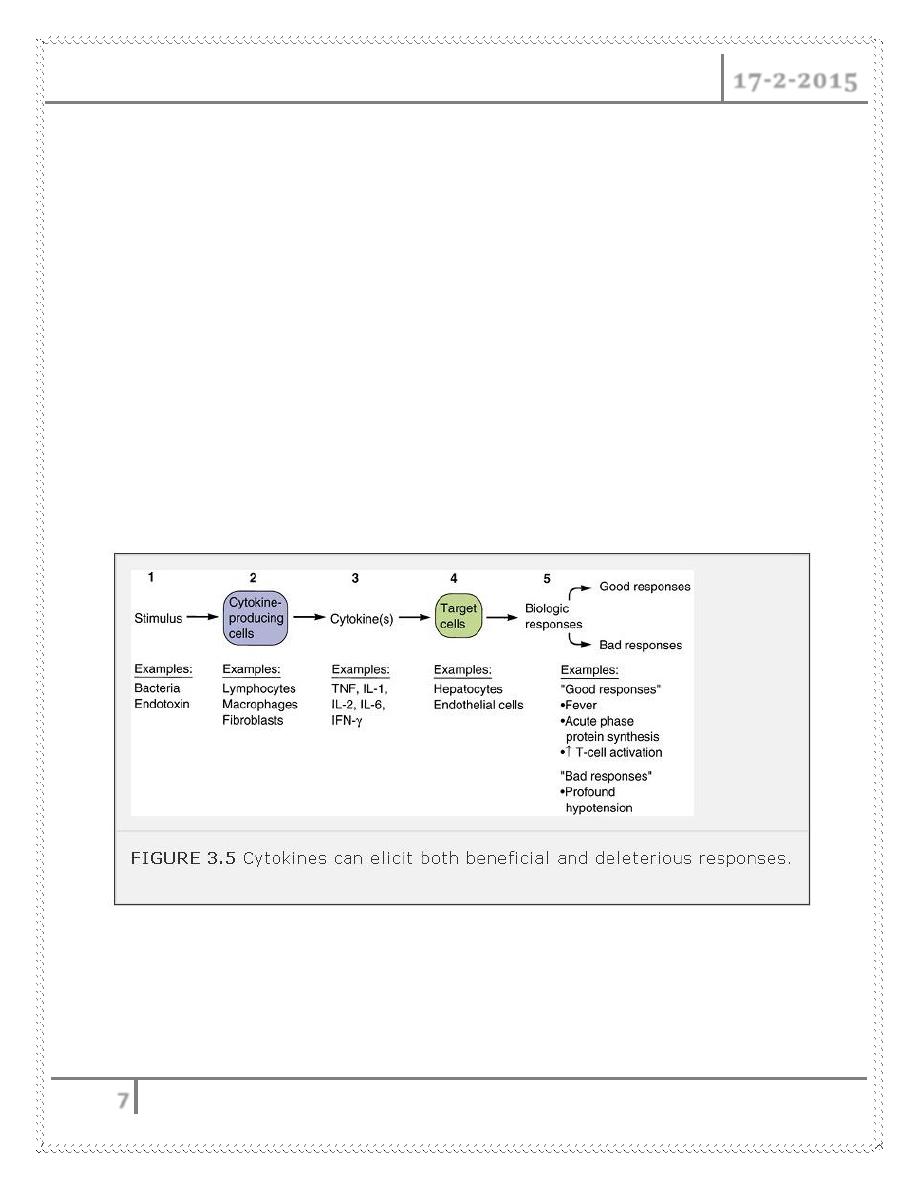
Metabolic Response in Injury Dr. Ramez
17-2-2015
7
Pro-inflammatory forms
Early
TNF, IL-1, IL-6,PGE2, LT4 (leukotriene-4)
TNF +PG+IL-1: acute phase response
- Fever, acute phase protein synthesis, insulin resistance
- Peak early and disappear from plasma
Stimulate IL-6 release: reduce level of insulin-like growth factor (IGF-1)
proteolysis and amino acid release from muscle, acute phase proteins
Anti-inflammatory forms
Inflammatory stimulus controlled and eliminated
Anti-inflammatory cytokines
IL-4, IL-10, IL-13, ecosanoids (PGE2,LT5)
Bring inflammatory response to conclusion
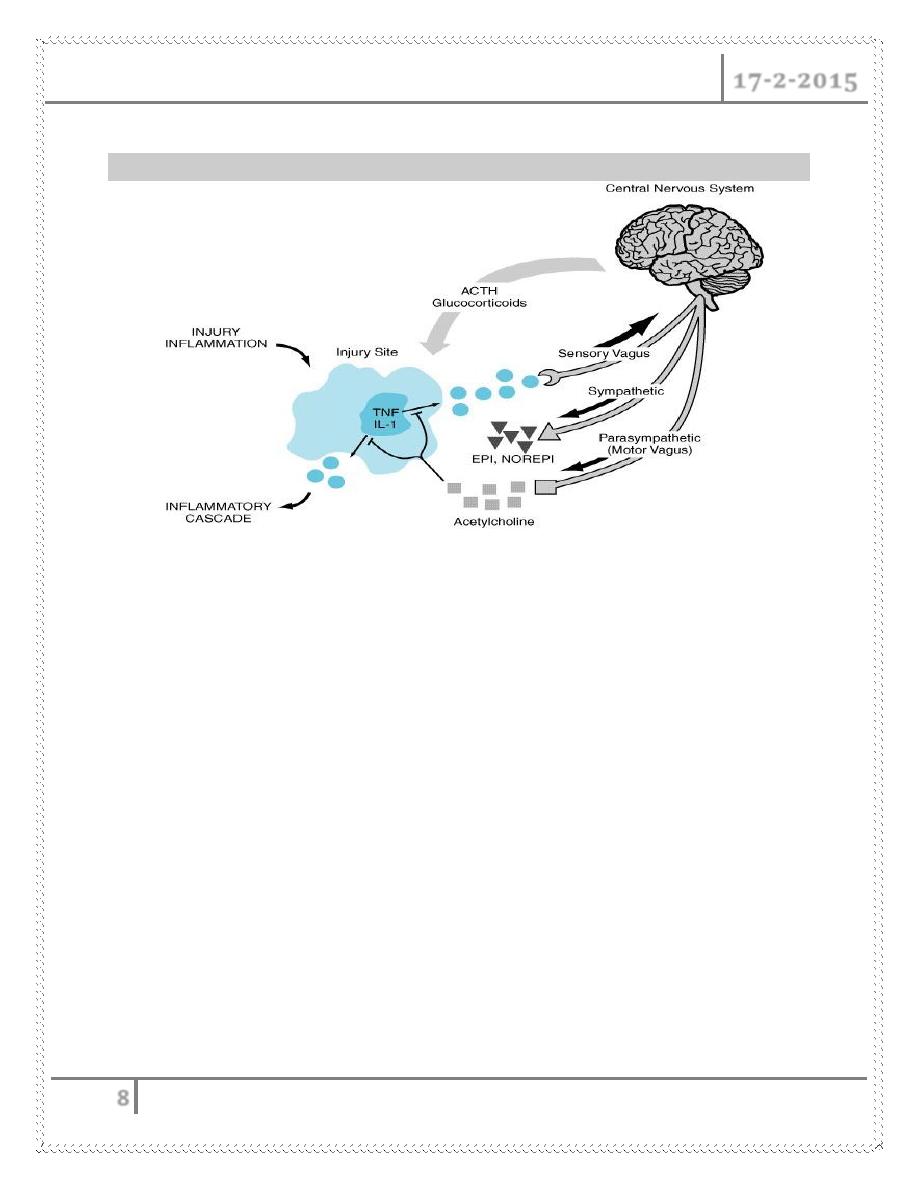
Metabolic Response in Injury Dr. Ramez
17-2-2015
8
Neurohormonal response
Neurohormonal response
Afferent stimuli to vagus nerve
- Cytokine (e.g. TNF-alpha, IL-1)
- Baroreceptors
- Chemoreceptors
- Thermoreceptors
CNS: hypothalamus
Parasympathetic: acetylcholine
- Reduces tissue macrophage activation
- Release of proinflammatory mediators (Anti-inflammatory pathways)
Glucagon, glucocorticoids and epinephrin
Ebb phase
- Epinephrine: sympthoadrenal axis help to maintain pressure, blood flow
Flow phase
- Glucagon: glycogenolytic and gluconeogenesis
- Cortisol: mobilized amino acids from skeletal muscle and increases
gluconeogenesis

Metabolic Response in Injury Dr. Ramez
17-2-2015
9
- Catecholamines: glycolysis and gluconeogenesis, increase lactate
production form skeletal muscle, increase metabolic rate and stimulate
lipolysis
Acute phase proteins
Fibrinogen
C-reactive protein
Inhibit generalized tissue destruction from inflammation
Volume loss and tissue hypoperfusion
Hemorrhage or plasma loss
compensate to maintain adequate organ
perfusion
Pressure receptors (aortic arch, carotid artery)
Volume receptors (wall of left atrium)
Signal to brain
Heart rate and stroke volume increase
Stimulate release of ADH and aldosterone
Prolonged shock
oxygen delivery inadequate
anaerobic metabolism
lactic acidosis
Tissue damage, Pain and Fear
Injury of body tissue: most important factor initiating stress response
Afferent neural pathways from wound
hypothalamus: injury occurred
Tissue destruction sensed in conscious patient as pain
Stress response (pain and fear)
Efferent pathways from brain
catecholamine
”fight or flight” response
END OF THIS LECTURE
Done by
Ali Kareem
